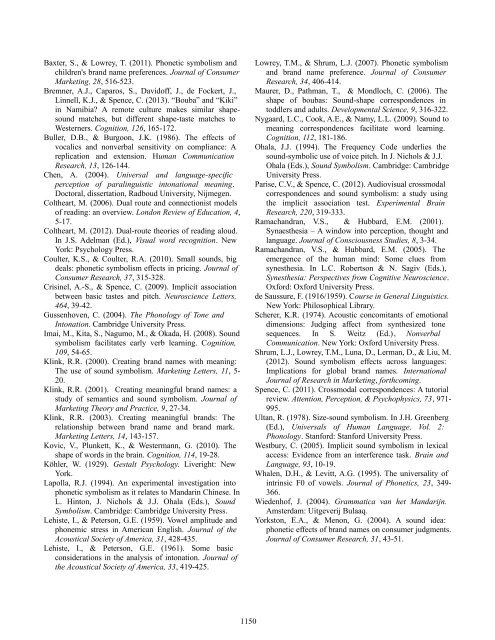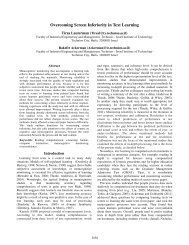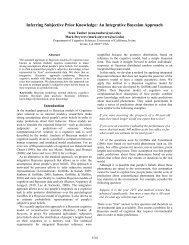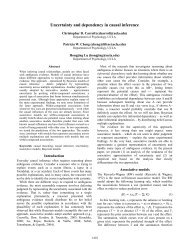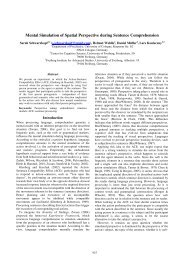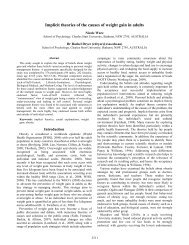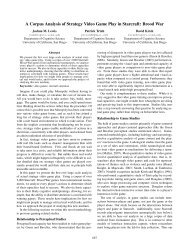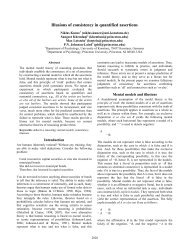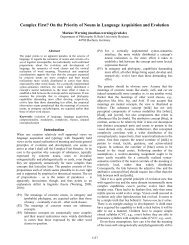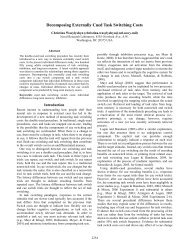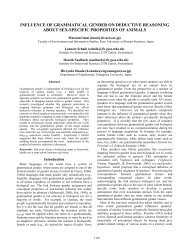Systematic Sound-Meaning Associations in Novel and Existing Words
Systematic Sound-Meaning Associations in Novel and Existing Words
Systematic Sound-Meaning Associations in Novel and Existing Words
Create successful ePaper yourself
Turn your PDF publications into a flip-book with our unique Google optimized e-Paper software.
Baxter, S., & Lowrey, T. (2011). Phonetic symbolism <strong>and</strong><br />
children's br<strong>and</strong> name preferences. Journal of Consumer<br />
Market<strong>in</strong>g, 28, 516-523.<br />
Bremner, A.J., Caparos, S., Davidoff, J., de Fockert, J.,<br />
L<strong>in</strong>nell, K.J., & Spence, C. (2013). “Bouba” <strong>and</strong> “Kiki”<br />
<strong>in</strong> Namibia? A remote culture makes similar shapesound<br />
matches, but different shape-taste matches to<br />
Westerners. Cognition, 126, 165-172.<br />
Buller, D.B., & Burgoon, J.K. (1986). The effects of<br />
vocalics <strong>and</strong> nonverbal sensitivity on compliance: A<br />
replication <strong>and</strong> extension. Human Communication<br />
Research, 13, 126-144.<br />
Chen, A. (2004). Universal <strong>and</strong> language-specific<br />
perception of paral<strong>in</strong>guistic <strong>in</strong>tonational mean<strong>in</strong>g.<br />
Doctoral, dissertation, Radboud University, Nijmegen.<br />
Coltheart, M. (2006). Dual route <strong>and</strong> connectionist models<br />
of read<strong>in</strong>g: an overview. London Review of Education, 4,<br />
5-17.<br />
Coltheart, M. (2012). Dual-route theories of read<strong>in</strong>g aloud.<br />
In J.S. Adelman (Ed.), Visual word recognition. New<br />
York: Psychology Press.<br />
Coulter, K.S., & Coulter, R.A. (2010). Small sounds, big<br />
deals: phonetic symbolism effects <strong>in</strong> pric<strong>in</strong>g. Journal of<br />
Consumer Research, 37, 315-328.<br />
Cris<strong>in</strong>el, A.-S., & Spence, C. (2009). Implicit association<br />
between basic tastes <strong>and</strong> pitch. Neuroscience Letters,<br />
464, 39-42.<br />
Gussenhoven, C. (2004). The Phonology of Tone <strong>and</strong><br />
Intonation. Cambridge University Press.<br />
Imai, M., Kita, S., Nagumo, M., & Okada, H. (2008). <strong>Sound</strong><br />
symbolism facilitates early verb learn<strong>in</strong>g. Cognition,<br />
109, 54-65.<br />
Kl<strong>in</strong>k, R.R. (2000). Creat<strong>in</strong>g br<strong>and</strong> names with mean<strong>in</strong>g:<br />
The use of sound symbolism. Market<strong>in</strong>g Letters, 11, 5-<br />
20.<br />
Kl<strong>in</strong>k, R.R. (2001). Creat<strong>in</strong>g mean<strong>in</strong>gful br<strong>and</strong> names: a<br />
study of semantics <strong>and</strong> sound symbolism. Journal of<br />
Market<strong>in</strong>g Theory <strong>and</strong> Practice, 9, 27-34.<br />
Kl<strong>in</strong>k, R.R. (2003). Creat<strong>in</strong>g mean<strong>in</strong>gful br<strong>and</strong>s: The<br />
relationship between br<strong>and</strong> name <strong>and</strong> br<strong>and</strong> mark.<br />
Market<strong>in</strong>g Letters, 14, 143-157.<br />
Kovic, V., Plunkett, K., & Westermann, G. (2010). The<br />
shape of words <strong>in</strong> the bra<strong>in</strong>. Cognition, 114, 19-28.<br />
Köhler, W. (1929). Gestalt Psychology. Liveright: New<br />
York.<br />
Lapolla, R.J. (1994). An experimental <strong>in</strong>vestigation <strong>in</strong>to<br />
phonetic symbolism as it relates to M<strong>and</strong>ar<strong>in</strong> Ch<strong>in</strong>ese. In<br />
L. H<strong>in</strong>ton, J. Nichols & J.J. Ohala (Eds.), <strong>Sound</strong><br />
Symbolism. Cambridge: Cambridge University Press.<br />
Lehiste, I., & Peterson, G.E. (1959). Vowel amplitude <strong>and</strong><br />
phonemic stress <strong>in</strong> American English. Journal of the<br />
Acoustical Society of America, 31, 428-435.<br />
Lehiste, I., & Peterson, G.E. (1961). Some basic<br />
considerations <strong>in</strong> the analysis of <strong>in</strong>tonation. Journal of<br />
the Acoustical Society of America, 33, 419-425.<br />
1150<br />
Lowrey, T.M., & Shrum, L.J. (2007). Phonetic symbolism<br />
<strong>and</strong> br<strong>and</strong> name preference. Journal of Consumer<br />
Research, 34, 406-414.<br />
Maurer, D., Pathman, T., & Mondloch, C. (2006). The<br />
shape of boubas: <strong>Sound</strong>-shape correspondences <strong>in</strong><br />
toddlers <strong>and</strong> adults. Developmental Science, 9, 316-322.<br />
Nygaard, L.C., Cook, A.E., & Namy, L.L. (2009). <strong>Sound</strong> to<br />
mean<strong>in</strong>g correspondences facilitate word learn<strong>in</strong>g.<br />
Cognition, 112, 181-186.<br />
Ohala, J.J. (1994). The Frequency Code underlies the<br />
sound-symbolic use of voice pitch. In J. Nichols & J.J.<br />
Ohala (Eds.), <strong>Sound</strong> Symbolism. Cambridge: Cambridge<br />
University Press.<br />
Parise, C.V., & Spence, C. (2012). Audiovisual crossmodal<br />
correspondences <strong>and</strong> sound symbolism: a study us<strong>in</strong>g<br />
the implicit association test. Experimental Bra<strong>in</strong><br />
Research, 220, 319-333.<br />
Ramach<strong>and</strong>ran, V.S., & Hubbard, E.M. (2001).<br />
Synaesthesia – A w<strong>in</strong>dow <strong>in</strong>to perception, thought <strong>and</strong><br />
language. Journal of Consciousness Studies, 8, 3-34.<br />
Ramach<strong>and</strong>ran, V.S., & Hubbard, E.M. (2005). The<br />
emergence of the human m<strong>in</strong>d: Some clues from<br />
synesthesia. In L.C. Robertson & N. Sagiv (Eds.),<br />
Synesthesia: Perspectives from Cognitive Neuroscience.<br />
Oxford: Oxford University Press.<br />
de Saussure, F. (1916/1959). Course <strong>in</strong> General L<strong>in</strong>guistics.<br />
New York: Philosophical Library.<br />
Scherer, K.R. (1974). Acoustic concomitants of emotional<br />
dimensions: Judg<strong>in</strong>g affect from synthesized tone<br />
sequences. In S. Weitz (Ed.), Nonverbal<br />
Communication. New York: Oxford University Press.<br />
Shrum, L.J., Lowrey, T.M., Luna, D., Lerman, D., & Liu, M.<br />
(2012). <strong>Sound</strong> symbolism effects across languages:<br />
Implications for global br<strong>and</strong> names. International<br />
Journal of Research <strong>in</strong> Market<strong>in</strong>g, forthcom<strong>in</strong>g.<br />
Spence, C. (2011). Crossmodal correspondences: A tutorial<br />
review. Attention, Perception, & Psychophysics, 73, 971-<br />
995.<br />
Ultan, R. (1978). Size-sound symbolism. In J.H. Greenberg<br />
(Ed.), Universals of Human Language, Vol. 2:<br />
Phonology. Stanford: Stanford University Press.<br />
Westbury, C. (2005). Implicit sound symbolism <strong>in</strong> lexical<br />
access: Evidence from an <strong>in</strong>terference task. Bra<strong>in</strong> <strong>and</strong><br />
Language, 93, 10-19.<br />
Whalen, D.H., & Levitt, A.G. (1995). The universality of<br />
<strong>in</strong>tr<strong>in</strong>sic F0 of vowels. Journal of Phonetics, 23, 349-<br />
366.<br />
Wiedenhof, J. (2004). Grammatica van het M<strong>and</strong>arijn.<br />
Amsterdam: Uitgeverij Bulaaq.<br />
Yorkston, E.A., & Menon, G. (2004). A sound idea:<br />
phonetic effects of br<strong>and</strong> names on consumer judgments.<br />
Journal of Consumer Research, 31, 43-51.


